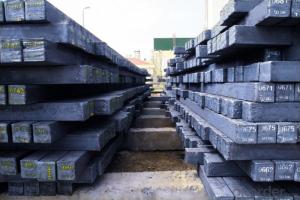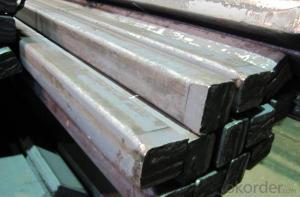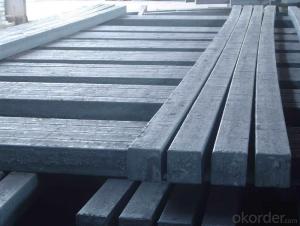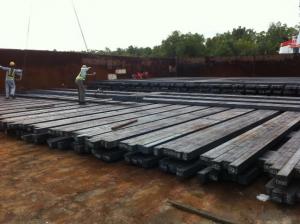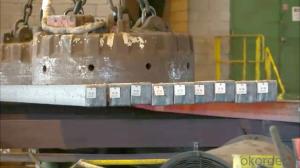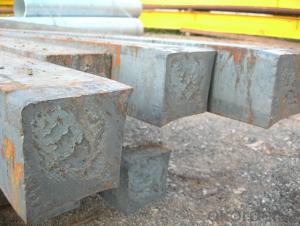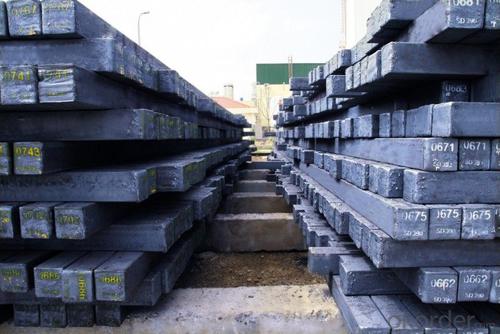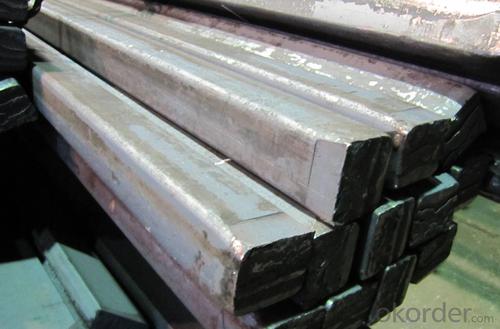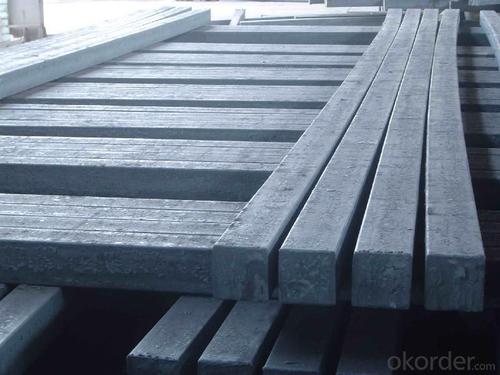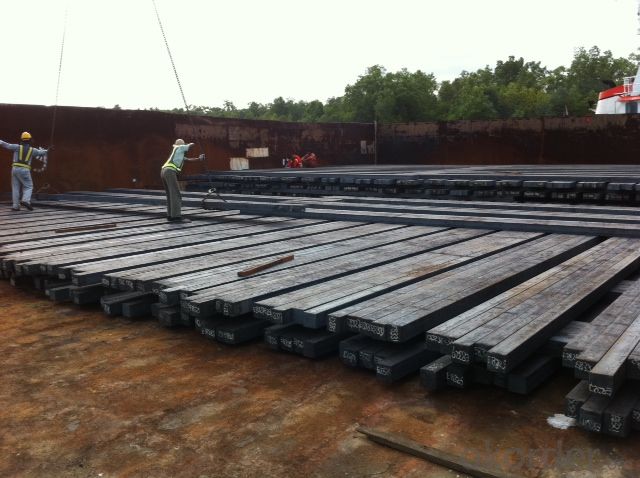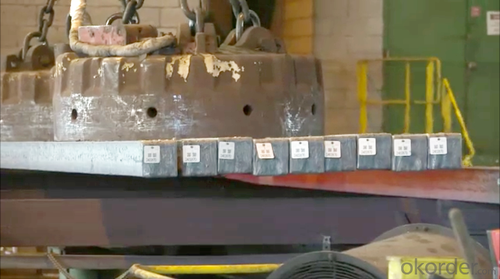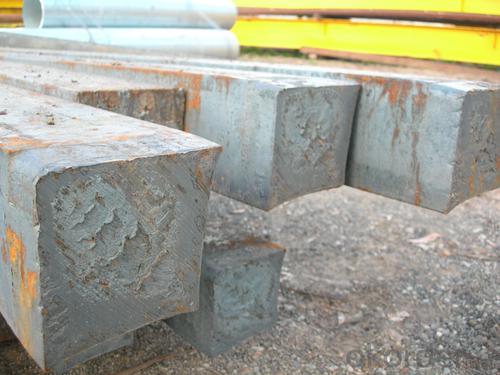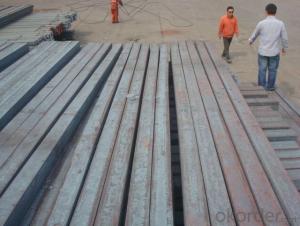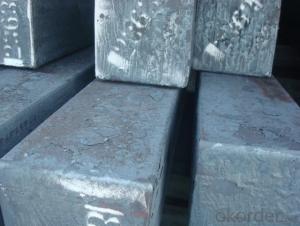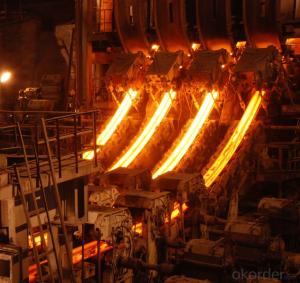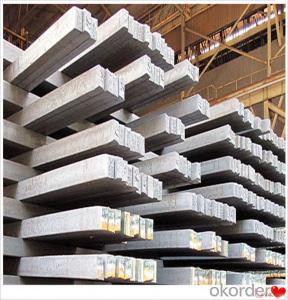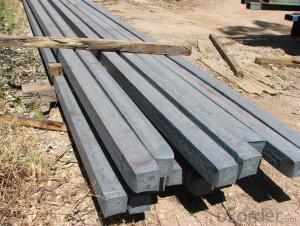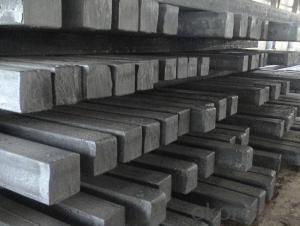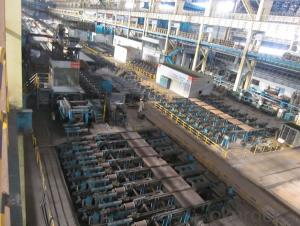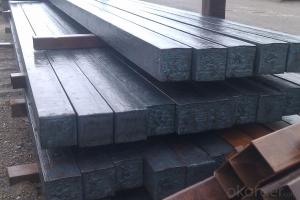Prime Q275 165mm Square Alloy Steel Billet
- Loading Port:
- Shanghai
- Payment Terms:
- TT OR LC
- Min Order Qty:
- 100 m.t.
- Supply Capability:
- 10000 m.t./month
OKorder Service Pledge
OKorder Financial Service
You Might Also Like
Structure of Prime Q275 165mm Square Alloy Steel Billet
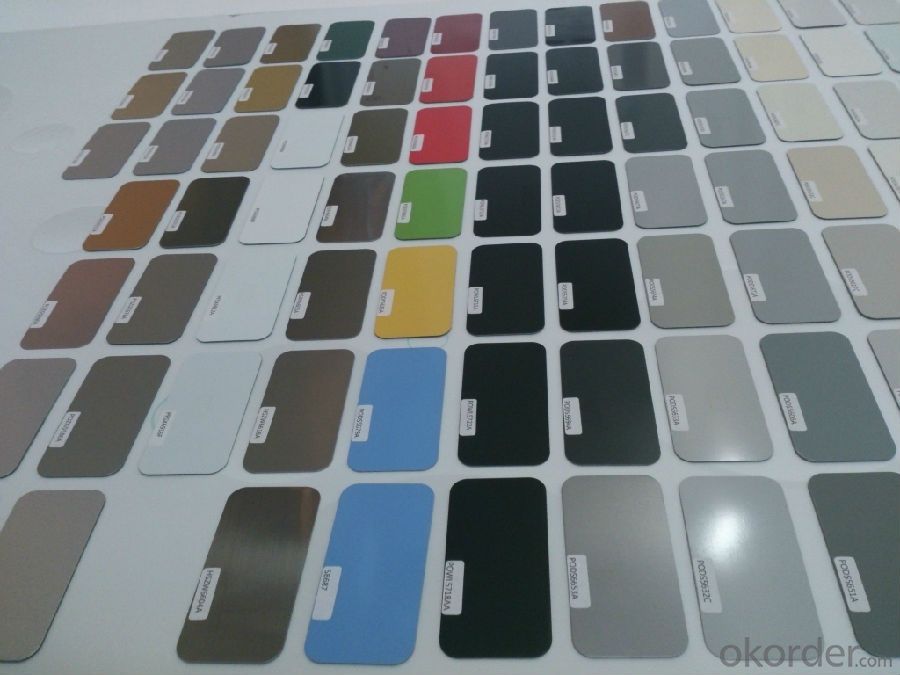
Description of Prime Q275 165mm Square Alloy Steel Billet
1. Prepainted steel coil is coated with organic layer, which provides higher anti-corrosion property and a longer lifespan than that of galvanized or galvalume steel sheets.
2. The base metals for prepainted steel coil consist of cold rolled, HDGI Steel, electro-galvanized and hot-dip alu-zinc coated steel. The finish coats of prepainted steel coil can be classified into groups as follows: polyester, silicon modified polyesters, polyvinylidene fluoride, high-durability polyester, etc.
3. The production process has evolved from one-coating-and-one-baking to double-coating-and-double-baking, and even three-coating-and-three-baking.
4. The color of the prepainted steel coil has a very wide selection, like orange, cream-colored, dark sky blue, sea blue, bright red, brick red, ivory white, porcelain blue, etc.
5. The prepainted steel coils can also be classified into groups by their surface textures, namely regular prepainted sheets, embossed sheets and printed sheets.
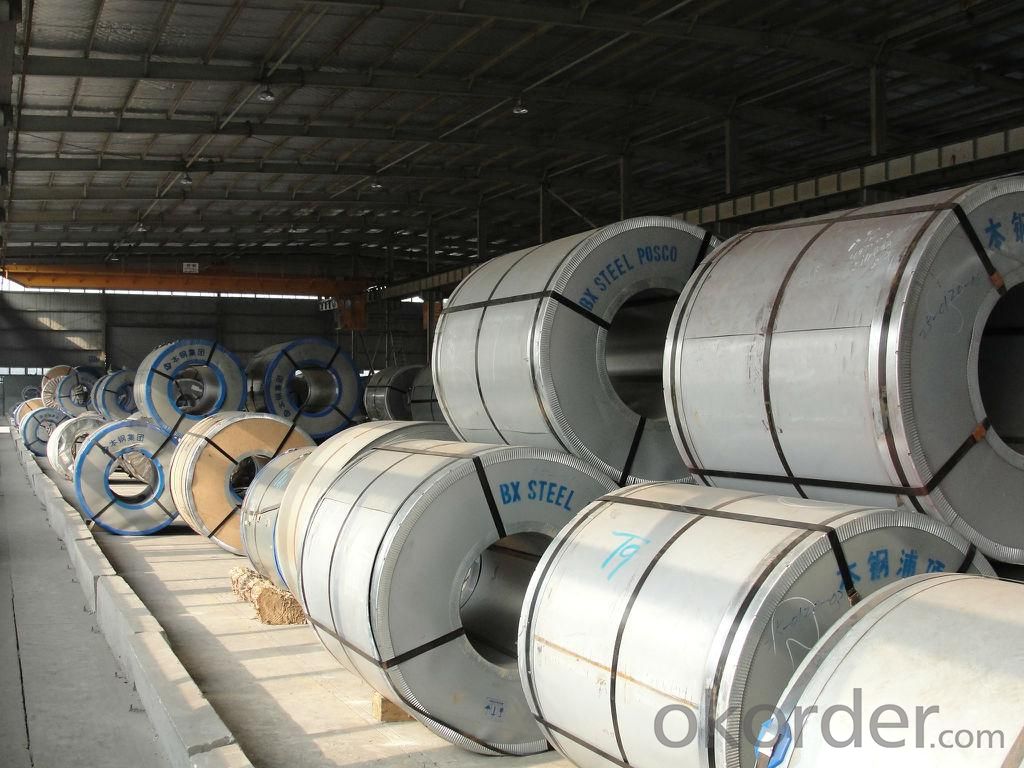
Main Feature of Prime Q275 165mm Square Alloy Steel Billet
They were one of several reasons for the wind to be taken out of the sails of the recent oil price momentum. Kuwait’s oil minister said that his country would only commit to a production freeze if all major producers are involved, including Iran. We also had Goldman telling us that oil markets will not rebalance at $40/bbl as it throws a lifeline to cash-strapped US producers.
If it is talk of a production freeze that is behind the rally it shows how low expectations have fallen. It is in the nature of oil people to talk the market up. Any bullish crumb is given exaggerated significance and any port in a storm will do. It is all but fact that the oil market will be tighter in the second half of this year when seasonal demand shoots up and US production continues to decline. It was the same picture last year. If OPEC and key non-OPEC production is frozen that will ensure the daily surplus will fall, but in all likelihood there will still be a surplus and there is an enormous global stockbuild to burn off.
Applications of Prime Q275 165mm Square Alloy Steel Billet
A. Corrugated design makes it excellent waterproof performance
B. Materials as prepainted steel sheets, galvanized steel sheets, galvalume (Al-Zn coated sheets) are available to make corrugated sheet.
C.Those material are durable, anti-corrosion in bad weather for 20-30 years based on it's Zinc(Galvanized) coating or AZ (Galvalume) coating.
D. Different shape of the sheet make it suitable for any style of buildings.
E.Easy to install, no need special tools to fix the sheet.
F.Light weight due to high strength to weight ratio of steel. Light weight means easier handling lower shipping costs, easier installation
G. Different color is availbe base on the RAL Standard make your building more beautiful.
H. We will provide the best solutions if you don't have a exact idea of the specification you want for the steel sheet based on your weather conditions, engineering structure, construction budget and so on.
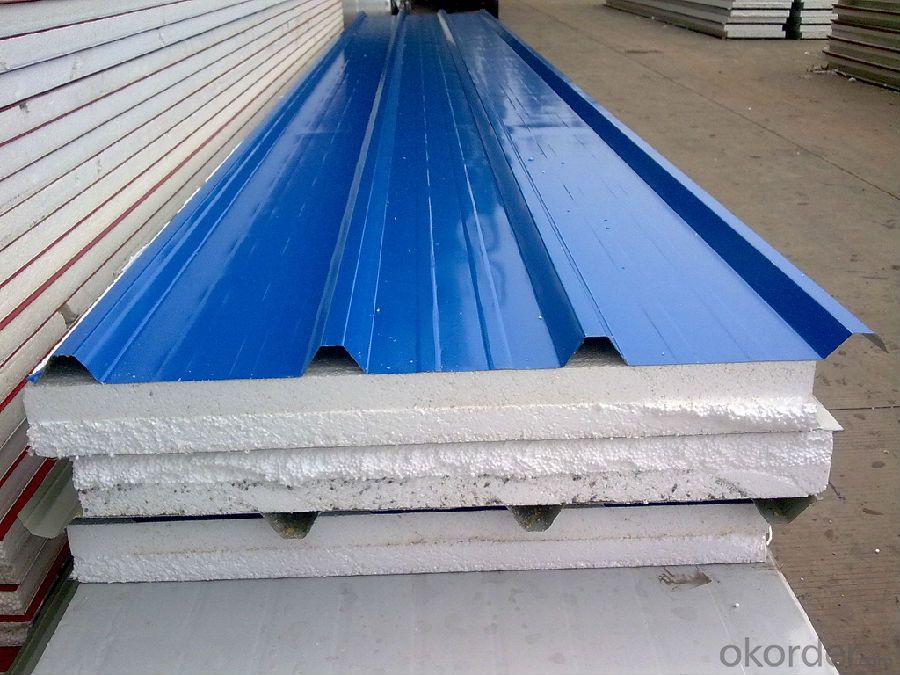
Specifications of Prime Q275 165mm Square Alloy Steel Billet
Product | Billet |
Material Grade | SGCC / SGCH / DX51D+AZ, etc |
Thickness | 0.6-3.0mm |
Width | 500-1500mm |
Tolerance | Thickness: +/-0.02mm , Width:+/-2mm |
Zinc-coating | Z30-150g/m2 |
Technique | Raw material: Hot rolled steel coil --> Cold rolled_>hot dipped galvalume |
Surface | Dried, Chromated, Unoiled |
Spangle | Regular spangle , small spangle, zero spangle |
ID | 508MM 610MM |
Coil weight | 1-25MT |
Export package | Cardboard inner sleeves, Waterproof paper, galvanized steel covered and steel strip packed |
FAQ of Prime Q275 165mm Square Alloy Steel Billet
We have organized several common questions for our clients,may help you sincerely:
1. How Can I Visit There?
Our company is located in Tianjin City, China, near Beijing. You can fly to Tianjin Airport Directly. All our clients, from home or aboard, are warmly welcome to visit us!
2. How Can I Get Some Sample?
Poor trade figures from China punctured commodity optimism yesterday although they came with warnings that perhaps the numbers were distorted by Chinese New Year celebrations and we will have to wait for the March figures to gain a true picture of the state of China’s landing. Exports for February were -25.4% and imports -13.8% year-on-year.
- Q: What are the different surface treatment methods used for steel billets?
- Some of the different surface treatment methods used for steel billets include shot blasting, pickling, and galvanizing. Shot blasting involves propelling steel shots at high speeds to remove any mill scale or surface impurities. Pickling involves immersing the billets in an acid solution to remove any oxide layers and create a clean surface. Galvanizing involves coating the billets with a layer of zinc to provide corrosion resistance. Other methods such as painting, phosphating, and powder coating may also be used for specific applications.
- Q: How are steel billets packaged for shipment?
- Steel billets are packaged in a manner that guarantees their protection and facilitates convenient handling for shipment. The packaging process involves multiple steps to ensure the safe transportation of the billets. First and foremost, the steel billets undergo inspection to ensure that they meet the required quality standards. Upon approval, they are cleaned and dried to eliminate any dirt or moisture that may cause corrosion during shipment. Following that, the billets are bundled together using steel strapping or wire to secure them in a compact form. This bundling not only prevents the billets from shifting or rolling during transportation but also makes it easier to handle and load them onto trucks or containers. Additionally, to provide further protection, the steel billets are often wrapped in a layer of plastic or paper. This extra layer acts as a barrier against moisture, dust, and other potential contaminants that could harm the billets during transit. Once the billets are bundled and wrapped, they are typically loaded onto pallets or placed in steel crates. This ensures stability during transportation and allows for ease of movement and stacking using forklifts or cranes. Lastly, the packaged steel billets are labeled with relevant information such as the product name, dimensions, weight, and destination. This labeling guarantees accurate identification and aids in the efficient handling and delivery of the billets. In summary, steel billets are packaged for shipment with a focus on protection, ease of handling, and efficient transportation. These packaging measures guarantee that the billets arrive at their destination in optimal condition, ready for further processing or utilization in various industries.
- Q: How do steel billets differ from steel ingots?
- Steel billets and steel ingots are both intermediate forms of steel that are produced during the steel manufacturing process. However, there are some key differences between them. Firstly, the shape and size of steel billets and steel ingots differ. Steel billets are typically square or rectangular in shape, with a cross-sectional area of around 36 square inches. They are long and slender, usually measuring around 6 to 12 inches in width and 1 to 12 feet in length. On the other hand, steel ingots are generally larger and more irregular in shape. They can be cylindrical, rectangular, or even a combination of shapes, depending on the production method used. Steel ingots are usually much larger than billets, with a typical weight ranging from several tons to over 100 tons. Secondly, the production process for steel billets and steel ingots also differs. Steel billets are usually created through continuous casting, where molten steel is poured into a mold and then cooled and solidified to form a billet. This process allows for a more controlled and uniform shape, size, and composition of the billet. Steel ingots, on the other hand, are typically produced through ingot casting, where molten steel is poured into a large mold and left to solidify. This method is often used for larger steel ingots and allows for a more flexible and adaptable production process. Lastly, the purpose and usage of steel billets and steel ingots also vary. Steel billets are commonly used as raw material for further processing and shaping into various steel products, such as bars, rods, wire, and tubes. They serve as a starting point for the manufacturing of finished steel products. Steel ingots, on the other hand, are usually used for more specialized applications, such as the production of large steel components, forgings, or specialty alloys. Their larger size and irregular shape make them suitable for such demanding applications. In summary, steel billets and steel ingots differ in terms of their shape, size, production process, and usage. While steel billets are slender, square or rectangular in shape, and used as raw material for further processing, steel ingots are larger, more irregularly shaped, and often used for specialized applications.
- Q: How do steel billets contribute to the manufacturing of water and wastewater treatment equipment?
- Steel billets play a crucial role in the manufacturing of water and wastewater treatment equipment. These billets are essentially semi-finished steel products that are used as raw materials for various industrial applications. When it comes to the water and wastewater treatment industry, steel billets are utilized in the production of key components such as tanks, pipes, valves, and pumps. One of the primary reasons steel billets are favored in this industry is due to their excellent strength and durability. Water and wastewater treatment equipment are subjected to harsh operating conditions, including exposure to corrosive chemicals, high pressure, and extreme temperatures. Steel billets, made from high-quality materials such as carbon steel or stainless steel, offer the necessary strength and resistance to withstand these demanding environments. Furthermore, steel billets can be easily fabricated and formed into different shapes and sizes, making them highly versatile for manufacturing water and wastewater treatment equipment. These billets can be forged, rolled, or extruded to create components with precise specifications, ensuring a perfect fit and optimal functionality. The corrosion resistance of stainless steel billets is particularly valuable in water and wastewater treatment equipment. These billets are highly resistant to rust and corrosion, preventing contamination of the water supply and ensuring the longevity of the equipment. Stainless steel billets are also hygienic, making them suitable for applications where maintaining water quality and cleanliness is of utmost importance. Additionally, steel billets offer cost-effectiveness in the manufacturing process. The abundance of steel as a material and its recyclability make it a cost-efficient choice for producing water and wastewater treatment equipment. The long lifespan of steel components also reduces the need for frequent replacements, resulting in lower maintenance and operational costs. In summary, steel billets are essential in the manufacturing of water and wastewater treatment equipment due to their strength, durability, versatility, corrosion resistance, and cost-effectiveness. These billets provide the necessary raw materials to create robust and reliable components that can withstand the challenging conditions of the water treatment industry.
- Q: How are steel billets used in the production of reinforcing bars?
- Steel billets are the primary raw material used in the production of reinforcing bars. They are heated and then passed through a series of rollers to shape them into the desired size and shape of the reinforcing bar. The billets are typically made from recycled steel, which is melted and then cast into billet form. These billets are then reheated and processed to transform them into strong and durable reinforcing bars, which are widely used in construction to strengthen concrete structures and provide structural support.
- Q: What are the potential applications of steel billets in the packaging aftermarket?
- Steel billets have various potential applications in the packaging aftermarket. They can be utilized for manufacturing sturdy and durable packaging materials such as steel drums, containers, and pallets. Steel billets provide excellent strength and impact resistance, making them ideal for protecting and transporting heavy or delicate goods. Additionally, their recyclability and sustainability make them a preferred choice for eco-conscious packaging solutions.
- Q: What is the melting point of steel billets?
- The melting point of steel billets may vary depending on the type of steel utilized. In general, the melting point of steel falls within the range of 1370 to 1530 degrees Celsius (2500 to 2800 degrees Fahrenheit). However, it is worth noting that diverse grades and compositions of steel can possess slightly different melting points. Moreover, factors such as impurities, alloying elements, and the inclusion of other metals in the steel can also influence the melting point. Consequently, it is always advisable to refer to the specific material specifications or seek guidance from metallurgical experts to obtain precise information regarding the melting point of steel billets.
- Q: What are the different types of steel billets available?
- There are several different types of steel billets available, each with its own unique properties and uses. Some of the most common types include: 1. Carbon Steel Billets: These are made primarily of iron and carbon, with trace amounts of other elements. They are known for their high strength and durability, making them suitable for a wide range of applications such as construction, automotive, and machinery manufacturing. 2. Alloy Steel Billets: As the name suggests, these billets are made by adding various alloying elements such as chromium, nickel, or manganese to the carbon steel. This enhances the mechanical properties of the steel, making it more resistant to corrosion, wear, and heat. Alloy steel billets are commonly used in the production of tools, gears, and high-strength components. 3. Stainless Steel Billets: These billets contain a minimum of 10.5% chromium, which gives them excellent corrosion resistance. Stainless steel billets are widely used in industries such as food processing, chemical, and medical, where hygiene and resistance to rust are crucial. 4. Tool Steel Billets: Designed for applications requiring high hardness, wear resistance, and toughness, tool steel billets are often used in the production of cutting tools, dies, and molds. They are made by adding elements such as tungsten, vanadium, or molybdenum to carbon steel, resulting in a material capable of withstanding extreme conditions. 5. Low Alloy Steel Billets: These billets contain small amounts of alloying elements, typically less than 5%, such as manganese, silicon, or copper. They offer improved strength, toughness, and weldability compared to carbon steel, making them suitable for structural applications in construction and engineering. 6. Microalloyed Steel Billets: Also known as HSLA (High-Strength Low-Alloy) steel, microalloyed steel billets contain small amounts of niobium, vanadium, or titanium. This results in a fine-grained microstructure and enhanced strength, allowing the production of lighter and more efficient structures in industries such as automotive and aerospace. These are just a few examples of the different types of steel billets available. Each type has its own specific properties and applications, and choosing the right type depends on the intended use and desired characteristics of the final product.
- Q: What are the different surface defects that can be found in steel billets?
- Some common surface defects that can be found in steel billets include cracks, scale, pits, inclusions, and surface roughness.
- Q: What are the main factors affecting the mechanical properties of steel billets?
- There are several main factors that can affect the mechanical properties of steel billets. 1. Chemical Composition: The chemical composition of steel, specifically the amounts of carbon, alloying elements, and impurities, plays a significant role in determining its mechanical properties. Higher carbon content usually leads to increased strength but reduced ductility. Alloying elements such as manganese, nickel, and chromium can enhance specific properties like hardness, toughness, or corrosion resistance. 2. Heat Treatment: The heat treatment process, which involves heating and cooling the steel billets under controlled conditions, can greatly influence their mechanical properties. Different heat treatment methods, such as annealing, quenching, and tempering, can alter the microstructure and consequently the hardness, strength, and toughness of the steel. 3. Microstructure: The microstructure of steel, which is determined by the cooling rate during solidification or heat treatment, is another crucial factor. The presence of different phases, grain size, and distribution of alloying elements within the microstructure can significantly affect the steel's mechanical properties. 4. Manufacturing Process: The manufacturing process used to produce steel billets can also impact their mechanical properties. Factors such as casting method, rolling or forging techniques, and the presence of any defects or impurities introduced during production can influence the final properties of the billets. 5. Temperature: Temperature has a considerable influence on the mechanical properties of steel. It can affect the strength, ductility, and toughness of the material. For instance, as temperature decreases, steel tends to become more brittle, whereas at elevated temperatures, it may exhibit reduced strength and increased ductility. 6. Strain Rate: The rate at which a load is applied to the steel billets, known as strain rate, can affect their mechanical properties. High strain rates, such as those experienced during rapid impact or dynamic loading, can result in different behavior and failure mechanisms compared to slower or static loading conditions. It is important to note that these factors are interrelated, and changes in one factor can influence others, leading to a complex interaction and a wide range of possible mechanical properties for steel billets.
Send your message to us
Prime Q275 165mm Square Alloy Steel Billet
- Loading Port:
- Shanghai
- Payment Terms:
- TT OR LC
- Min Order Qty:
- 100 m.t.
- Supply Capability:
- 10000 m.t./month
OKorder Service Pledge
OKorder Financial Service
Similar products
Hot products
Hot Searches
Related keywords
